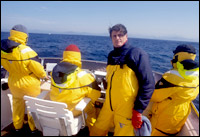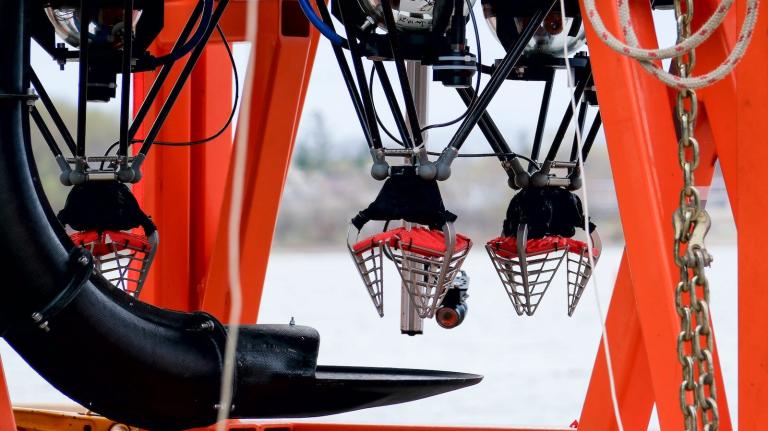
Allan Thornton.
What work do you do?
I run the Environmental Investigation Agency, a nonprofit environmental group with offices in Washington, D.C., and London. I generally oversee the strategic development of the organization, which includes targeting research, deploying investigative teams to obtain documentary evidence, and exposing environmental crimes; I work in close cooperation with our directors, campaigners, and investigators.
What does your organization do?
We campaign to protect the natural environment using investigation — often undercover — to document and expose environmental crimes around the world. We focus on several areas: illegal logging and the international trade in illegal logs, timber, and wood; illegal trade in endangered or threatened species; and illegal trade in ozone-depleting chemicals like CFCs (chlorofluorocarbons, or refrigerants, also used in air conditioning) and more recently, methyl bromide. I don’t believe that we will ever “put ourselves out of business.” Negative impacts by human society on the environment will be with us for a long time, and environmental crime is growing bigger each year as globalization continues.
What do you really do, on a day-to-day basis? What are you working on at the moment?
My favorite work involves developing and executing strategies, working with our team to devise investigations, and creating political strategies to increase environmental protection, enforcement of existing laws, or improvements in laws that are weak or inadequate.
It has been an extremely busy time recently. Right now we have very intensive work on our illegal-logging campaigns and strategies.
Dave Currey, my codirector in our London office, led a two-year investigation into a billion-dollar-a-year log-smuggling operation from Papua province in Indonesia to China. Our report, produced with Telapak, a leading Indonesian group, was released in mid-February and has resulted in the new Indonesian president launching the biggest crackdown on illegal logging in history, with arrests of the head of the forestry department in Papua, army personnel, police, Malaysian financiers, and the president of a Malaysian company in Papua. They have seized more than 2 million cubic feet of logs, 700 pieces of heavy equipment, 14 boats, 4 barges, 40 chainsaws, etc.
We are also talking to U.S. timber industry representatives to support banning the import of illegal timber; the U.S. industry has estimated they are losing at least $450 million a year due to illegal logging.
We also do a lot of wildlife campaigning. We document commercial hunting of whales, dolphins, and porpoises in Japan, where up to 17,000 small whales, dolphins, and porpoises are still killed each year. We tested the whale and dolphin products we found on sale in Japanese supermarkets and discovered many contained mercury levels ten times higher than legally allowed by Japanese government rules for food for human consumption. We also provided the information to U.S. based subsidiaries of the major Japanese retailers, and over 2,100 Japanese supermarkets and retail outlets have stopped selling whale, dolphin, and porpoise products.
We have a team in Africa tracking illegal ivory trade out of southern Africa; there is an ivory smuggling route that moves poached elephant ivory from Zambia, Zimbabwe, and other countries out of a South African port through Singapore and on to China and Japan. We are working with local enforcement and providing training and enforcement advice. We produced a video on ivory-smuggling techniques that has been released only to government enforcement authorities and the wildlife-trafficking group of Interpol.
What long and winding road led you to your current position?

Thornton and crew on the high seas.
I started out as an aspiring writer, a novelist. I moved to Vancouver, B.C., and began volunteering with the fledgling Greenpeace organization in 1975 when it was one small desk, no full-time staff, and just one office worldwide (they are now in more than 40 countries). I went to London the next year and set up an office of Greenpeace there, the first in Europe. I met a few people who wanted to save the whales. After 18 months raising funds, we purchased the original Rainbow Warrior in 1978. With a friend in Paris, Remi Parmentier, who set up and ran the Greenpeace office there, we launched Rainbow Warrior campaigns against whale hunts in Iceland and Spain and radioactive waste dumping in the North Atlantic Ocean. Greenpeace had explosive growth, driven by the success and worldwide publicity generated by the Rainbow Warrior campaigns and crew. I was lucky to sail with great crews and navigators.
Once, we were sailing 80 miles off the coast of Iceland, tracking Icelandic whale hunters looking to harpoon fin whales. They started chasing them and we raced our little inflatable boats across the choppy ocean into their firing line. Two huge fin whales burst up in front of us, swimming for their lives, as the dark figure of the harpoonist crouched over his harpoon gun was silhouetted by the bright summer sun. Everything went into slow motion, and I could see the beautiful pinkish skin of the whales and the fine mist shooting from their spouts against a perfect blue sky dotted with small, wispy clouds. I sensed death about us; then the harpoonist slammed the safety catch back onto the harpoon, and we slipped back into real time. The Rainbow Warrior crew had saved our first whale. But it took eight more years of campaigning before Iceland stopped its commercial whale hunt.
I left Greenpeace in early 1982 and started independent projects. I went to Turkey and documented and exposed the dolphin hunt in the Black Sea, where 25,000 dolphins were being shot each year. I came to Washington, D.C., and with the help of the late Christine Stevens, head of the Animal Welfare Institute, got a letter signed by 36 U.S. senators to the Turkish ambassador asking for the hunt to be stopped. Six weeks later it was stopped — that was early 1983. That year, I raised funds and bought a boat, and with two friends — future codirectors of EIA Dave Currey and Jenny Lonsdale — sailed to northern Norway to film the hunting of minke whales; 1,600 a year were being killed with non-exploding harpoons. Norwegian whaling fleets have killed more whales than any other country in the world — over 750,000. On that trip, we decided to set up the Environmental Investigation Agency.
We started investigating various whale and dolphin hunts around the world and the mass trade in wild-caught birds sold to the pet trade — where three out of every four birds die before they reach the person buying them at a pet shop. (The U.S. banned most bird imports in the early 1990s.)
We then began a two-year undercover investigation into the international trade in illegal ivory that took us from the killing fields in Africa — where 70,000 elephants were being poached each year for the ivory trade. We tracked the trade through the Middle East to Hong Kong, Singapore, Taiwan, Japan, and back to the U.S. and Europe. Five Hong Kong-based syndicates controlled the whole trade, and the bigger environmental groups were afraid to name names and told us, “You guys are going to get killed.” By the end of our investigations, Dave Currey was looking under his car for bombs, and I was barricading my door every night. We had discovered the involvement of the South African military under the apartheid government, and by the time we moved to our exposé in 1989, we were being followed by agents of the South African military.
When our exposé was released, all hell broke loose, as the conservation establishment had been supporting continued ivory trade despite the rapid decline in elephant populations. In 1989, the international ivory trade was banned — and Africa’s elephants got the breathing space to recover their numbers after decades of massive poaching.
Where were you born? Where do you live now?
I was born in Windsor, Ontario, across from Detroit; it’s the Canadian side of the motor city. Everyone works in a car factory or a factory that makes parts for cars. It was a very polluted environment; swimming in the Detroit River was banned when I was eight, and an acidic brown ash would float down over the city from the foundries in Detroit and eat into the paint on people’s cars — so it wasn’t great for people’s lungs.
I live in Washington, D.C., now.
What has been the worst moment in your professional life to date?
In 1997, in Harare, Zimbabwe, member countries of CITES (Convention on International Trade in Endangered Species) agreed to allow international trade in elephant ivory. Robert Mugabe, the president of Zimbabwe — supported by WWF — pushed the measure through. Elephant poaching in Africa shot up immediately. If you’ve seen elephants in the wild in Africa, then seen elephant carcasses, it is a profoundly disturbing and sad experience.
What’s been the best?
There’s been a lot, fortunately. The 1989 ban on ivory trade. President Clinton, urged by then-Secretary of Interior Bruce Babbitt, enacting trade sanctions against Taiwan for its brazen rhino-horn and tiger-part trade — after we exposed a criminal gang that sold six tons of rhino horn to Chinese government officials. The 1982 moratorium on commercial whale hunting. The signing of the nuclear test ban treaty. Seeing a Pershing missile in the Smithsonian Museum — where they all belong.
What environmental offense has infuriated you the most?
There’s also a lot of these. Recently, it’s the U.S. commercial agro-interests that persuaded the U.S. administration to renege on its agreement to stop using methyl bromide and obtained “Critical Use” exemptions from the Montreal Protocol for continued use of 30 million pounds of methyl bromide for fumigating strawberry farms, tomatoes, and similar produce. The ozone layer continues to thin and people get it confused with global warming, which is a separate issue.
Also, the failure of the U.S. timber industry and the government of China to take action against international trade in illegally produced timber.
Who is your environmental hero?
Prior to 2001, it was Ralph Nader. Now it is colleagues from Telapak in Indonesia and Father Tamayo in Honduras, who are in the front line to stop illegal logging and facing real dangers.
For the pragmatic environmentalist, what should be the focus — political action designed to change policy, or individual action designed to change lifestyle?
We need both — urgently. We need to demand real action to protect the environment and also have to reduce our mindless consumerism and waste of resources.
What’s your favorite place or ecosystem?
East Maui was a recent favorite, and the northern circuit of national parks in Tanzania.
What’s one thing the environmental movement is doing particularly well?
Expanding public and political concern about the illegal logging and timber trade.
What’s one thing the environmental movement is doing badly, and how could it be done better?
Saving orangutans that are losing their forest habitats in Indonesia and Malaysia.
If you could institute by fiat one environmental reform, what would it be?
Ban the import, sale, and transport of illegally produced logs, timber, or wood products.
What was your favorite band when you were 18? How about now?
18 — The Beatles. Now — U2.
What’s your favorite TV show? Movie?
The West Wing. Alias. Sometimes Casablanca, or Gladiator.
What are you happy about right now?
It’s a beautiful spring day with a mockingbird performing its repertoire outside. I have a lovely, happy, and healthy daughter and wife. And a team just arrived back from Central America from an investigation.
If you could have every InterActivist reader do one thing, what would it be?
Support EIA with money, skills, or contacts. Enjoy every day of your life.


